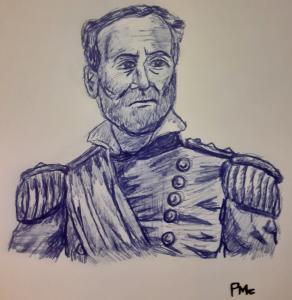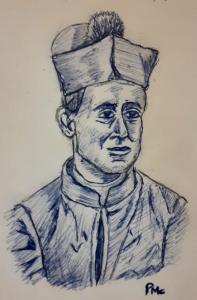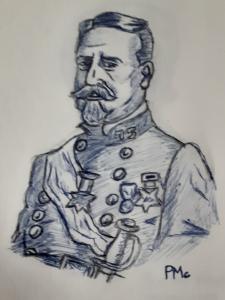![historyofstjohns00taafuoft_0127[1]](https://wp-media.patheos.com/blogs/sites/224/2013/11/historyofstjohns00taafuoft_01271-287x300.jpg)
Father John Larkin, S.J., St. John ‘s College, Fordham (1801-1858)
Larkin, John, S.J., fifth president of St. John’s College, Fordham, was born in 1801 in the county of Durham, England, and after pursuing his classical studies at Upshaw under Dr. Lingard, in the same class with Cardinal Wiseman, undertook a journey to Hindostan [India], and on his return studied theology at Paris, in the seminary of St. Sulpice. About 1830, being then a priest, he was sent to occupy the chair of philosophy in the Sulpician college in Montreal. He became a Jesuit in 1841. In 1846 he was stationed at Fordham. In 1847 we find him on his way to New York City, with fifty cents in his pocket, to purchase a house and a church. Divine Providence aided and he ere long dedicated a church to the Holy Name of Jesus. This church was burned on January 28, 1848. While Father Larkin was busily engaged in his search after a site for a new college, he was astounded one day by a letter from the Archbishop of Quebec, congratulating him on his promotion to the episcopacy, and stating that His Grace had been ordered by Rome to consecrate him for the see of Toronto. A copy of the brief accompanied this letter. Mr Larkin returned the brief unopened, and started at once for Europe to avert the impending dignity. On arriving in France he obtained leave to make his tertianship or third year of probation at Laon, and through the influence of his superiors escaped the Bishopric of Toronto. Leaving Laon he went to Laval to study, and in 1851 he was made rector of St. John’s, Fordham. Father Larkin was one of the handsomest, most courtly and most learned men that was ever at Fordham. He was a man among men—a man once seen never to be forgotten. Possessed of great personal magnetism, he was popular alike with the students and his faculty, and it is probable no other president ever exerted such an extraordinary influence over pupils of all ages as he exercised—an influence that did not cease with the college life, but made itself felt in after years and stamped the future career of many of the men who were disciplined by him as boys. The best service that Father Larkin rendered at Fordham College was in the development of character, which is, after all, the principal and most important part of a man’s education. He had original methods of instructing his classes, avoided routine work, and using the text-books as little as possible, he endeavored to train his pupils to the practice of independent reasoning and thinking. During his term of office the Know-Nothing troubles were at their highest and two meetings were held on Fordham Heights for the purpose of organizing to burn the college. A blacksmith on the Kingsbridge road threatened to expose the plot if they did not desist, and the attack on the college was frustrated. The government subsequently furnished the college with twelve muskets for the better defense of the institution. Some of these muskets may still be seen in the property-room of the College Dramatic Society. The first effort made at journalism at St. John’s was in 1853, when the “Goose Quill” was started. The pages were headed and ruled like printed paper. The editors were John R.G. Hassard, Arthus Francis and Martin T. McMahon of the class of ’55. Father Larkin had conservative ideas on such subjects, and opposed the undertaking from the start, and always barely tolerated it. He would not permit the editors to have it printed or circulated outside of the college. The “Goose Quill” ceased to exist shortly after the original corps of editors were graduated. It was during Father Larkin’s rectorship that the celebrated Father Louis Jouin, S.J., the famous philosopher, mathematician and linguist came to Fordham. He has since been thoroughly identified with the college, and is now (1892) professor of philosophy at Fordham. In 1854 Father Larkin resigned the president’s chair at St. John’s. He was then called to England, thence to Ireland, and back again to New York. He died at Fordham December 11, 1858.
The National Cyclopaedia of American Biography (New York: J.T. White, 1893), Volume II, 265-266.











